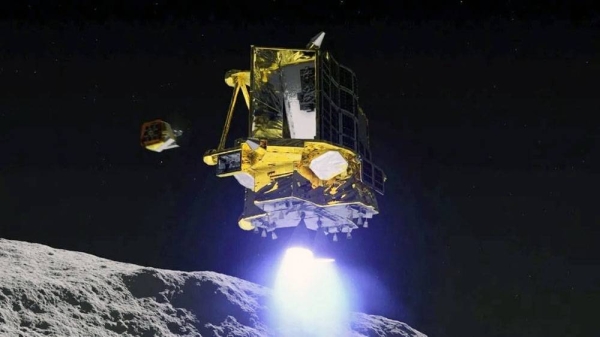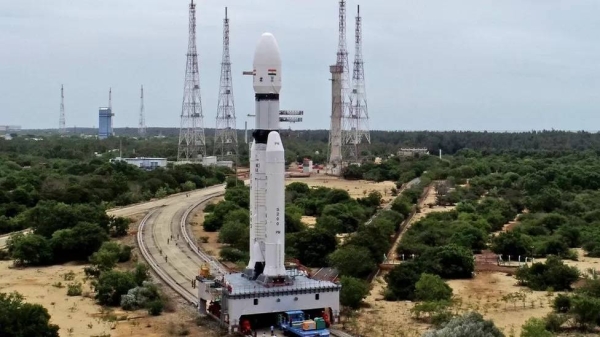
Japan’s hopes to become the fifth country to land a working spacecraft softly on the moon ran into difficulties on Friday after mission controllers said the probe was unable to generate electricity after touchdown.
The Smart Lander for Investigating Moon (Slim) was trialling new technologies for pinpoint landings, but after an apparently flawless approach and descent, the mission hit a glitch when the probe landed soon after 3pm UK time.
Although the space agency was receiving signals from Slim and a tiny rover it released moments before touchdown, a problem with the lander’s solar panels meant it was operating purely on existing battery power. It was possible the lander’s solar panels were not angled correctly towards the sun, officials said.
“Slim is now operating only on its battery, and we are prioritising the transfer of its data to Earth,” Hitoshi Kuninaka, the head of the Japanese Aerospace Exploration Agency (Jaxa)’s space lab, told reporters at a press conference two hours after the lander touched down.
The lander’s battery is expected to drain within a matter of hours, but it may be possible to generate electricity onboard if the sun’s movement in coming weeks casts light on the solar cells.
The space agency believes Slim achieved a soft landing, but it is expected to take a month or so to confirm whether the lander touched down within 100 metres of its target site near the Shioli crater, just south of the lunar equator – a major goal for the mission.
If the probe achieved the hoped-for precision, it would mark a shift from an era of “landing where we can” to “landing where we want”, Jaxa said. Such high-precision landings will be crucial for the future exploration of the moon.
It is unclear how serious the solar panel problem is, but the glitch is a disappointment for Jaxa, which abandoned its first attempt to touch down on the moon in 2022 when it lost contact with the Omotenashi lander. Last year, a private lunar mission from the Tokyo-based company iSpace crash landed on the surface.
Slim swung into lunar orbit on Christmas Day after taking a fuel-efficient, months-long route to the moon. At about 3pm on Friday UK time, it began its “powered descent sequence”, using AI-based image recognition to spot patterns of craters on the surface and locate its landing site.
All appeared to be going smoothly, with data from the spacecraft suggesting a steady descent and touchdown, but officials were initially unable to confirm the lander’s status when it reached the surface.
Moon missions are back in favour with major space agencies amid plans to return humans to the surface and exploit water and other resources found there. But while the Soviet Union and the US both nailed soft landings in the 1960s, the Soviet Luna 24 mission in 1976 was the last to do so until 2013, when China’s Chang’e 3 touched down. India became the fourth nation to join the elite club in 2023 with its Chandrayaan-3 lander.
Landing on the moon is far from straightforward. On Thursday, the private US Peregrine moon lander fell back to Earth and burned up over the south Pacific Ocean after it developed a fuel leak soon after launch. Last year, Russia’s Luna 25 spacecraft crash landed on the moon nearly 60 years after the Soviet Union’s Luna 9 made the first soft touchdown on lunar soil.
Moments before landing, Slim released two palm-sized lunar excursion vehicles, or Levs. The first, Lev-1, was designed to hop around and take measurements with an onboard thermometer, radiation monitor and slope sensor, and send signals back to Earth. The second, a ball-shaped mini-rover designed with Takara Tomy, the toy firm behind Transformers, uses the same shape-changing technology to pop open, revealing two cameras and turning the two hemispheres into wheels.
For mission controllers, any science the mission can perform will be a bonus. One hope is for an onboard camera to study exposed mantle material at the landing site, to see if it supports the theory that the moon formed in a giant impact with Earth.
Katherine Joy, a professor in earth sciences at the University of Manchester, who has studied lunar samples from the Apollo programme, said the fact that Slim was sending and receiving signals implied Japan was now the fifth country to achieve a soft landing on the moon. “That’s wonderful news,” she said. “However, the solar panels are not charging up as planned. What this means for mission longevity or to achieve the science goals is to be seen over the next few hours to days.”











